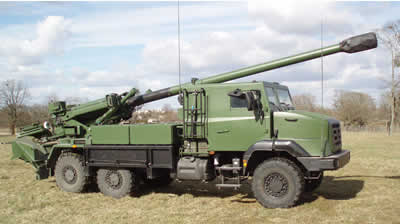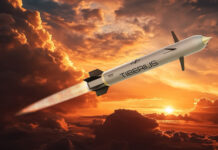New ammunition currently under development could extend the current effective range of artillery beyond 40 km, which was the realistic limit of conventional 39 and 45 caliber 155mm guns. In the UK, QINETIQ, the prime contractor for Team IMPAQT‘s Advanced Ordnance demonstrator program, is developing a composite airframe design suitable for precision delivery of a variety of payloads. IMPAQT aims at the development of a new type of artillery ammunition capable of attacking targets with an accuracy of less than 10 meters, at a range of 80 km. The British consortium is currently evaluating three IMPAQT munitions. One is an extended range variant utilizing roll stabilized projectile which employs an attitude controlled steel projectile to deliver two BONUS sensor fused munitions or a unitary warhead to a range beyond 60 km. A different variant uses an advanced lightweight composite projectile to deploy three BONUS SFMs to a range of 75km. The third will utilize composite projectile form making precision attacks over a wide area from a single 155mm round.
Two versions of precision attack artillery munitions are already in service with European armies. Germany, Greece and Switzerland are fielding the Rheinmetall Waffe Munition’s SMArt 155 (DM702) intelligent, autonomous artillery round while, BONUS, designed primarily to engage mobile, armored formations, is in service with Sweden and France (over 4,500 rounds have been produced). A twin-warhead BONUS MkII Sensor Fuzed Munition (SFM) is in development, fitted with IR and profile detector sensors, enabling target discrimination and detection even through camouflage. Further work is being done on a new version of BONUS Insensitive Munition (IM), to address current restrictions imposed by European regulations. BAE Systems Bofors and GIAT are developing the BONUS IM for consideration for the British Indirect Fire Precision Attack (IFPA) program. BONUS could also be part of the program’s advanced phases, addressing Guided Artillery Shells.
Aerodynamic projectile design will also enable range performance similar to conventional ordnance systems with reduced barrel pressures, matching the capabilities of lightweight artillery platforms. This program is pursued as a joint initiative supported by the defense ministries of France and the UK as part of the IMPAQT team, including GIAT, BAE Systems Bofors, MBDA and Qinetiq. Rheinmetall was recently able to fire Dm131 155mm high explosive artillery rounds at ranges over 40 km. This round uses insensitive explosive and is loaded with DM662 bomblets. DM131 has been accepted by the German Army and is currently in production for the Netherlands and Greece.
To improve the precision of current artillery projectiles, the US Army is pursuing the development of Precision Guidance Kit (PGK) upgrades for its 155mm ammunition stockpiles. Under the 6 months technology demonstration program, the Army will evaluate several proposals, to be followed with down-select the final PGK system. ATK, with team members Rockwell Collins and Draper Labs are proposing a PGK utilizing a GPS guidance and navigation system designed to fit the fuze well of an existing 155mm round. ATK’s PGK solution features fixed canard guidance, gun-hardened electronics, self-generated power, and a minimum number of moving parts. The company expects its system will exceed the Army’s requirements for accuracy, effectiveness, range, and cost.
Another multinational program is the Excalibur – a cooperative effort between Raytheon Missile Systems and BAE Systems Bofors of Sweden for developing a GPS guided projectile, providing current 155mm artillery with high precision attack capability at extended ranges. In June 2006 the U.S. Army awarded Raytheon Company a $42.7 million production contract for tactical and test projectiles. The US Army is already pursuing Block 1B upgrades for Excalibur with the Saber program. A successful test firing of the Saber was conducted in June 2006. The advanced projectile was fired to a range of 48 km from a 155mm cannon.
Other recent Improvements made to conventional munitions primarily address adherence to Insensitive Munitions regulations which have been imposed by the European community. GIAT is already manufacturing insensitive artillery ammunition, producing the 155mm LU211-IM for the Caesar. Artillery rounds using Insensitive Explosives are also in production at BAE Systems. In May 2006 the company opened its new production facility, with filling capacity of more than 375,000 shells per year, at Glascoed, UK. Specializing in insensitive explosives, the new facility is filling 105mm and 155mm shells with Rowanex 1100 Polymer Bonded Explosive (PBX). Under a new 12,000 105mm HE improved ammunition shells are to be delivered by October 2006.
105mm artillery is again becoming popular among many armies due to the high mobility and low weight of the 105 mm gun, which makes it suitable for supporting Rapid Deployment Forces. IMI is also entering the field of 105mm ammunition and is developing a new series 105mm artillery projectiles that are designed to fit all types of 105mm artillery systems currently in service. The new range will include Dual Purpose Incendiary Counter Material (DPICM) and Extended Range (ER) ammunition. Hollow Base (HB) versions extend the reach of 105mm guns up to 14 km and the extended range Base Bleed (BB) versions, currently in development, will reach ranges beyond 20km. IMI’s 105mm cargo round carries 42 “Hornet” bomblets, each equipped with IMI’s combat proven Self-Destruct Fuze (SDF) the same fuse used for the 155 mm cargo projectiles. Each bomblet produces has a kill radius of approx. five meters and can penetrate more than 50 mm of RHA steel. Smoke, illumination and WP rounds are also available.




















